Keyword Overview is ons rapport van het hoogste niveau waarmee je elk zoekwoord kunt opzoeken in de Semrush-database. Wanneer je een woord of woordgroep in de zoekbalk hebt ingevoerd, zie je voor dat zoekwoord het zoekvolume (op nationaal, wereldwijd en lokaal niveau), de intentie, het aantal resultaten, de CPC, het concurrentieniveau, de volumetrend en meer.
- Onderzoek op het hoogste niveau van om het even welk zoekwoord in de Semrush-database
- Onmiddellijke beoordeling van de geschatte waarde en concurrentie van een zoekwoord
- Portaal naar rapporten over diepere zoekwoordanalyse in de software
- Optie om zoekwoorden vanuit het tabblad Bulk Analysis rechtstreeks naar de Keyword Strategy Builder te sturen
- Gepersonaliseerde inzichten voor zoekwoordanalyse, ondersteund door AI
Bij digitale marketing hebben je zoekwoorden zowel met jou als met je potentiële klanten een raakvlak. Je kunt je richten op bepaalde zoekwoorden door het plaatsen van content op je website of via een advertentiebudget op Google Ads.
Maar voordat je verkeer kunt genereren via zoekopdrachten, moet je besluiten welke zoekwoorden de moeite waard zijn om je op te richten. Dit is waarom zoekwoordanalyse zo belangrijk is.
Het Keyword Overview-rapport is de beste plaats om je zoekwoordanalyse te starten en jezelf vertrouwd te maken met de rapporten en statistieken van Semrush.
De waarde van een zoekwoord analyseren
Wanneer je een Keyword Overview-rapport lanceert, geeft Semrush je een initiële evaluatie van de waarde van het zoekwoord.
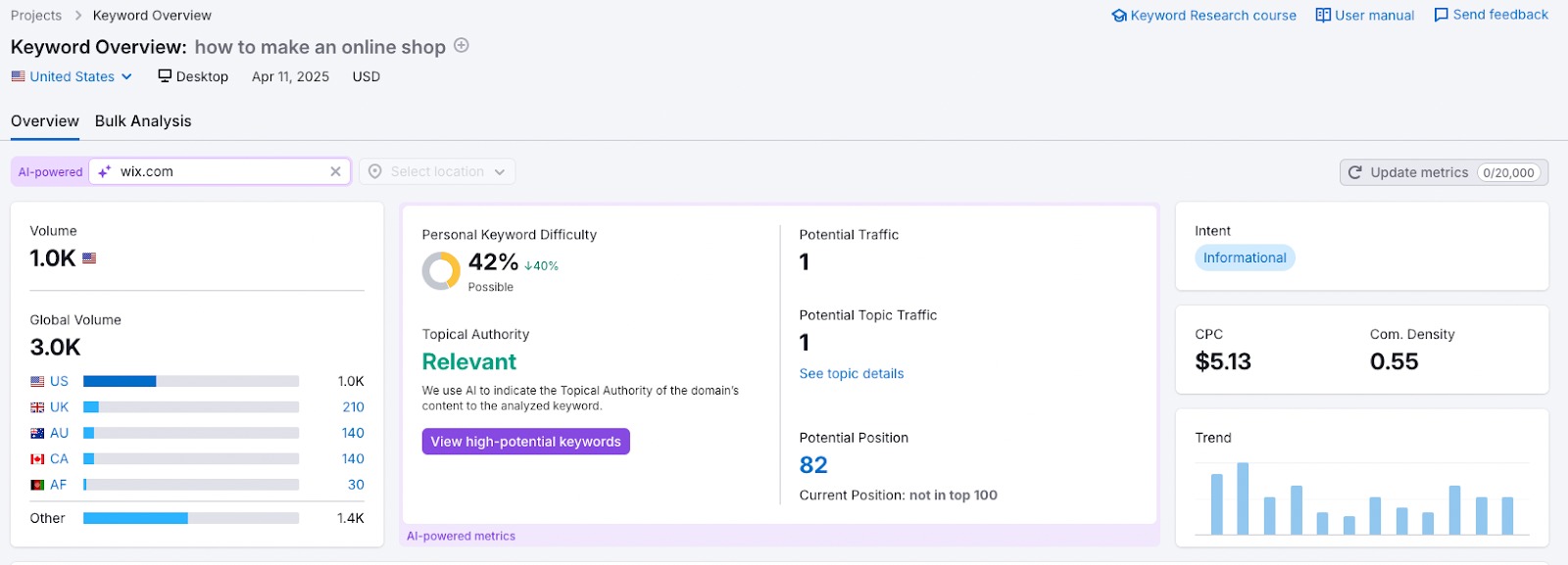
- Volume: het gemiddeld aantal keer per maand dat via Google op een zoekwoord werd gezocht (op nationaal/lokaal niveau).
- Wereldwijd volume: het gecombineerde totale maandelijkse zoekvolume van een zoekwoord in al onze nationale databases.
- Gepersonaliseerde zoekwoordmoeilijkheid (PKD): wordt berekend met behulp van AI-algoritmes die de relevantie van een domein voor een specifiek zoekwoord analyseren. Ontdek hier hoe het wordt berekend.
- Potentieel verkeer wordt berekend met behulp van AI-algoritmes die het domeinspecifieke verkeer voor een zoekwoord en het relevante thema inschatten. Ontdek hier hoe het wordt berekend.
- Thematische autoriteit:: de relevantie van de content van een domein voor het geanalyseerde zoekwoord. Ontdek hier hoe het wordt berekend.
- Potentiële SERP-positie: je huidige en potentiële positie voor een geanalyseerd zoekwoord
- Intentie: het doel van een zoekopdracht die door een gebruiker wordt ingevoerd in een zoekmachine. Intenties kunnen door zoekmachine-algoritmes worden gelezen om de gepaste resultaten en SERP-functies weer te geven. De belangrijkste types zoekintenties zijn: informerend, navigerend, commercieel en transactioneel.
- CPC: de kosten per klik die een adverteerder aan Google betaalt voor een klik op diens PPC-advertentie op de SERP van het zoekwoord.
- Concurrentiedichtheid: de dichtheid van adverteerders die op dit zoekwoord bieden voor hun advertenties op nationaal niveau. Een score van 1,00 duidt op het hoogste concurrentieniveau, terwijl een score van 0,00 aanduidt dat er helemaal geen concurrentie is. Hoewel deze statistiek betrekking heeft op concurrenten bij betaalde zoekresultaten, kan ze ook representatief zijn voor de organische waarde van een zoekwoord.
- Trend: de interesse in een bepaald zoekwoord in de voorbije 12 maanden.
Als je het zoekvolume kent, kun je inschatten hoe populair een zoekwoord is. Populariteit is echter niet het belangrijkste aspect wanneer je kiest op welke zoekwoorden je je gaat richten.
De intentie van een zoekwoord controleren
Je kunt je zoekwoordanalyse nog verder verrijken met geautomatiseerde intentieanalyse in Semrush. We hebben de zoekintentie voor elk zoekwoord in onze databases geanalyseerd, zodat je snel kunt ontdekken waar gebruikers naar zoeken en met welke bedoeling. In het tabblad Bulk Analysis kun je de intentie van een gebruiker en verschillende andere belangrijke statistieken analyseren voor tot wel 100 van je doelzoekwoorden tegelijkertijd.

Tip: gebruik de tool Keyword Gap om hiaten te vinden in de zoekwoordstrategieën van meerdere concurrenten.
Zoekwoordvariaties, vragen en zoekwoordclusters
De widget Zoekwoordideeën geeft een selectie weer van vergelijkbare groepen zoekwoorden die je kunt gebruiken om je ideale doelzoekwoorden te vinden.
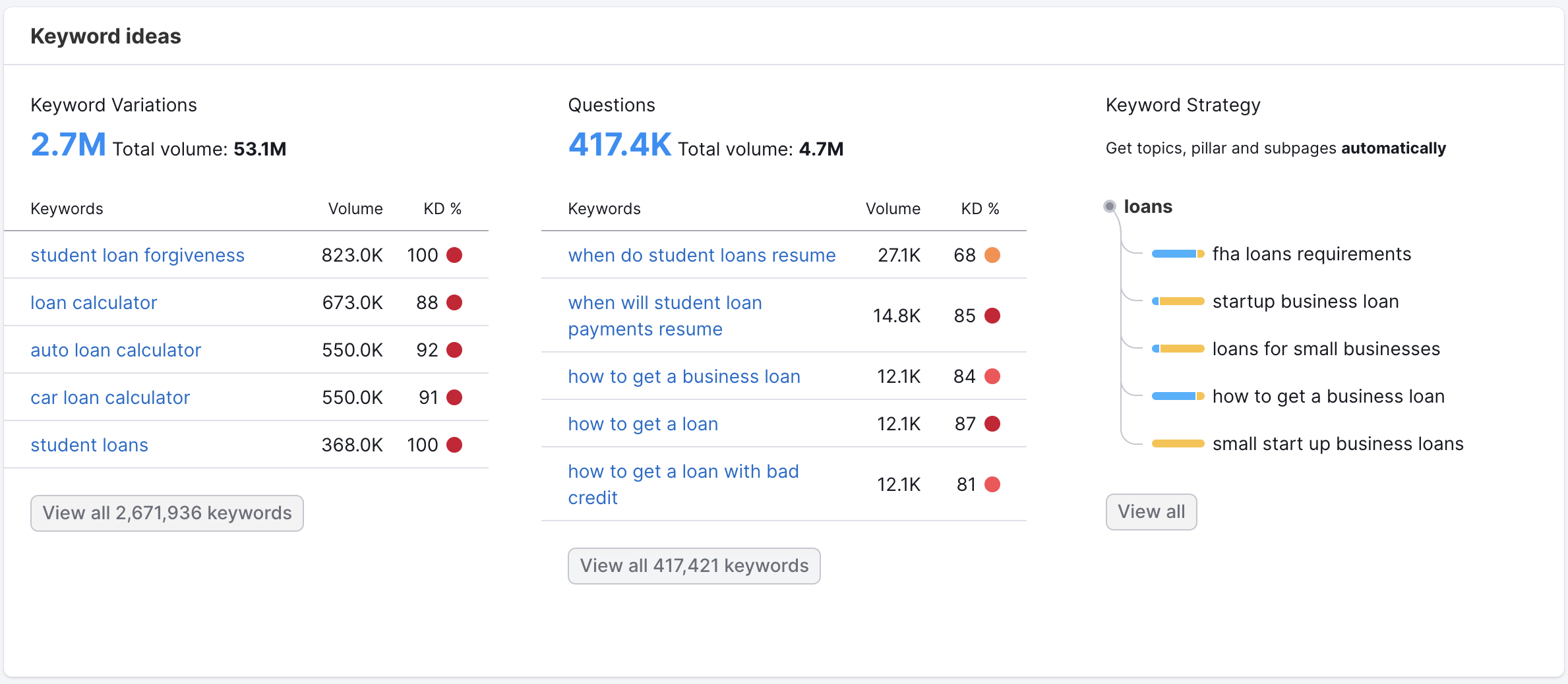
- Zoekwoordvariaties: woordgroepen met zowel je oorspronkelijke zoekwoord als met aanvullende woorden of aanpassingen. Zoekwoordvariaties helpen je om de populairste zoekopdrachten te vinden die gerelateerd zijn aan jouw voornaamste zoekopdracht.
- Vragen: zoektermen waarin Semrush een "wie, wat, waar, wanneer, waarom, hoe, is, kan, enz." herkent. Vragen zijn handig om ideeën voor content te genereren voor blogartikelen, FAQ en contentpagina's op je website. Het beantwoorden van veelgestelde vragen kan helpen bij je SEO, inclusief optimalisatie voor spraakgestuurd zoeken.
- Zoekwoordstrategie: groepen zoekwoorden waarvoor een pagina goed kan ranken. Keyword Overview geeft een lijst voorbeeldclusters weer en biedt een link naar het volledige rapport in de Keyword Strategy Builder. Zoekwoordclusters zijn alleen beschikbaar voor rapporten op nationaal niveau.
- Gepersonaliseerde zoekwoordmoeilijkheid (PKD %): PKD biedt zoekwoorden met aangepaste moeilijkheidsscores, zodat ze bij jouw domein passen en dus weerklank vinden bij jouw unieke omstandigheden. Hierdoor kun je exclusieve, eenvoudig toegankelijke zoekwoordmogelijkheden op maat van jouw domein identificeren.
Deze gegevens worden rechtstreeks uit onze Keyword Magic Tool gehaald, waardoor je ook informatie krijgt over het totale volume en de gemiddelde zoekwoordmoeilijkheid. Als je op het aantal zoekwoordsuggesties klikt, word je rechtstreeks naar de Keyword Magic Tool gebracht.
De trend controleren
De trend van een zoekwoord helpt je de seizoensgebondenheid van je doelpubliek te begrijpen en te voorspellen wanneer het genereren van verkeer met een bepaald zoekwoord tot seizoensgebonden pieken zal leiden.
De trendgrafiek in dit rapport geeft weer of het zoekvolume van een zoekwoord in de loop van het jaar schommelt of relatief constant blijft. De staven stellen de vorige 12 maanden voor, waarbij de laatste altijd overeenkomt met de voorbije maand.
Als we bijvoorbeeld een zoekwoord zouden analyseren in mei 2025, zou de eerste staaf (aan de linkerkant) mei 2024 voorstellen en de laatste april 2025.
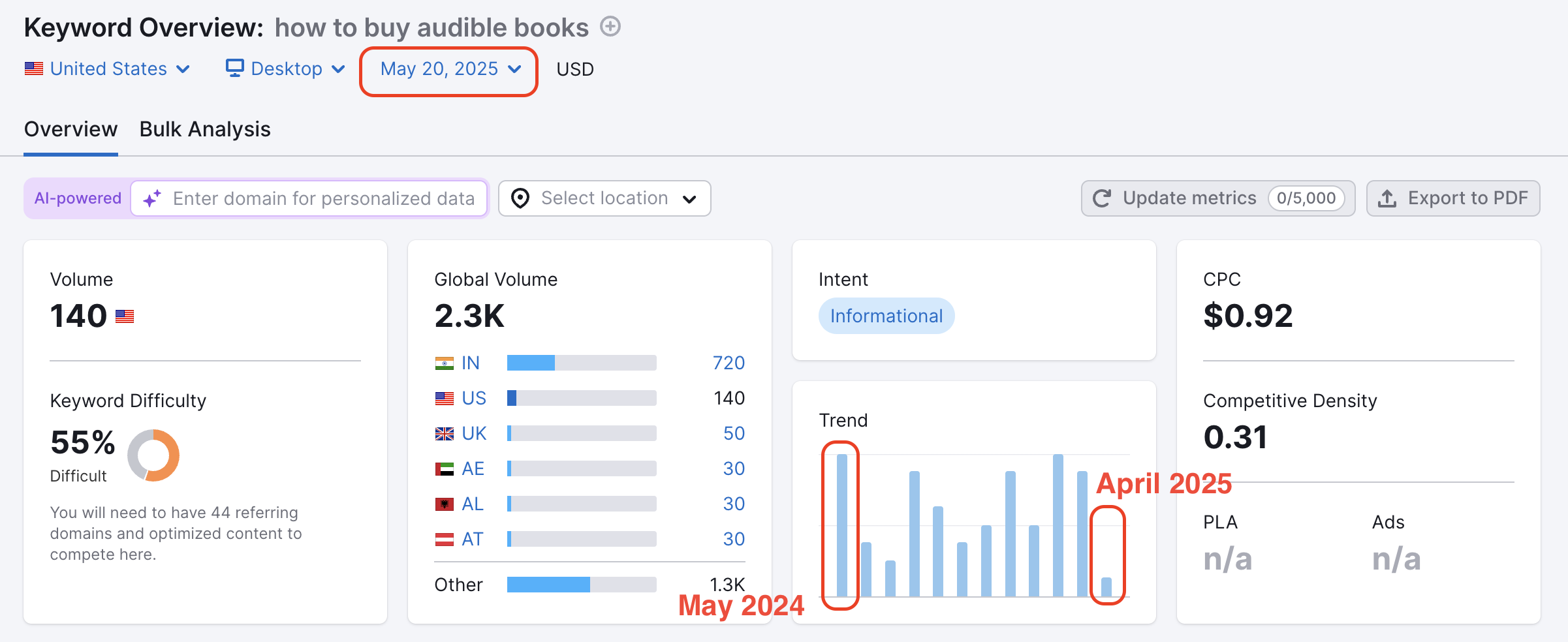
Als je merkt dat de trend van een zoekwoord geen pieken vertoont en op hetzelfde niveau blijft, moet je ervoor zorgen dat je je het hele jaar lang op dit zoekwoord richt.
Je kunt wel dienovereenkomstig plannen als een zoekwoord seizoensgebonden pieken kent. Een zoekwoord als "badpakken" kan in de lente en zomer bijvoorbeeld populairder zijn.
Je kunt de strategie van je website daarop afstemmen door seizoensgebonden websitecontent te publiceren of door een reclamecampagne te lanceren waarmee je je op dit zoekwoord richt.
De organische waarde van een zoekwoord analyseren
Als je naar beneden scrolt, zie je dat het Keyword Overview-rapport de belangrijkste domeinen vermeldt waarvan de landingspagina's in de organische zoekresultaten verschijnen voor de zoekterm die je aan het analyseren bent.
Je kunt de SERP bekijken met de blauwe link "SERP bekijken" en je kunt realtime statistieken voor deze best presterende websites zien met de knop "Gegevens updaten" bovenaan het rapport.

Je potentiële bereik geeft de concurrentiekracht van jouw domein weer om voor dat zoekwoord te ranken. Hiermee wordt gemeten hoe waarschijnlijk het is dat jouw domein voor specifieke zoekwoorden kan ranken vergeleken met de concurrentie. Het is een statistiek die helpt bij strategische planning door duidelijk weer te geven waar je staat ten opzichte van je concurrenten en door gebieden te identificeren waar je mogelijk kunt domineren.

Als je jouw website in deze lijst ziet... gefeliciteerd! Google beschouwt jouw webpagina als een van de beste en meest relevante voor het opgegeven zoekwoord. Maar loop de kans niet mis om je ranking te versterken en te verbeteren.
Tip: je kunt elk onderdeel van het rapport exporteren in XLSX- of CSV-formaat.
De advertentiewaarde van een zoekwoord analyseren
Als je website niet van nature rankt voor bepaalde zoekwoorden, kun je toch zoekverkeer genereren door op zoekwoorden te bieden via Google Ads.
Onder de organische vermeldingen vind je ook de belangrijkste PLA-teksten (productadvertenties) en advertentieteksten (Google Ads) die voor een zoekwoord in de betaalde zoekresultaten verschijnen. Gebruik deze ter inspiratie om je eigen advertentieteksten te schrijven en analyseer de landingspagina's waarnaar ze verwijzen.

Als je een e-commercewebsite hebt, let dan goed op de bovenste productadvertenties. Deze adverteerders zijn je belangrijkste concurrenten voor Google Shopping.
De widget Eerdere zoekwoordadvertenties laat je zien hoe actief websites op nationaal niveau op het zoekwoord hebben geboden in de vorige 12 maanden. Klik erop om naar het rapport Eerdere zoekwoordadvertenties te gaan, dat meer informatie bevat.
Door Semrush Keyword Analytics te gebruiken, kun je te weten komen welke van je advertenties het afgelopen jaar het best hebben gepresteerd. Met deze informatie kun je vervolgens zien welke strategieën de beste ROI opleveren en dat gebruiken om zoekadvertenties in de toekomst met succes te blijven gebruiken.
Als je het geanalyseerde zoekwoord al gebruikte voor je reclamecampagnes, kun je deze gegevens gebruiken om de zoekzichtbaarheid van je advertenties te verbeteren.
Nu je vertrouwd bent met het opvragen van een Keyword Overview-rapport, bekijk je het best ook eens onze Keyword Magic Tool, waarmee je je nog grondiger in zoekwoordanalyse kunt verdiepen.
Tip: gebruik het selectiepijltje bovenaan om historische gegevens voor een zoekwoord te bekijken.
Lokale zoekwoordstatistieken
Het is niet alleen mogelijk om zoekwoordstatistieken op nationaal niveau te bekijken, maar ook op lokaal niveau.
Let op: domeingebaseerde zoekwoordstatistieken zijn niet beschikbaar voor lokale zoekwoordanalyse.
Met deze filter kun je het potentieel voor organisch verkeer van een zoekwoord op jouw specifieke locatie evalueren, een locatiespecifieke lijst met doelzoekwoorden maken, betere zoekwoordplanningen ontwikkelen voor een lokale SEO-campagne, en nog veel meer.
Op de Keyword Overview-landingspagina kun je een zoekwoord invoeren, een lokale sublocatie, stad of regio kiezen als locatie, en op Zoeken klikken om lokale gegevens te krijgen.
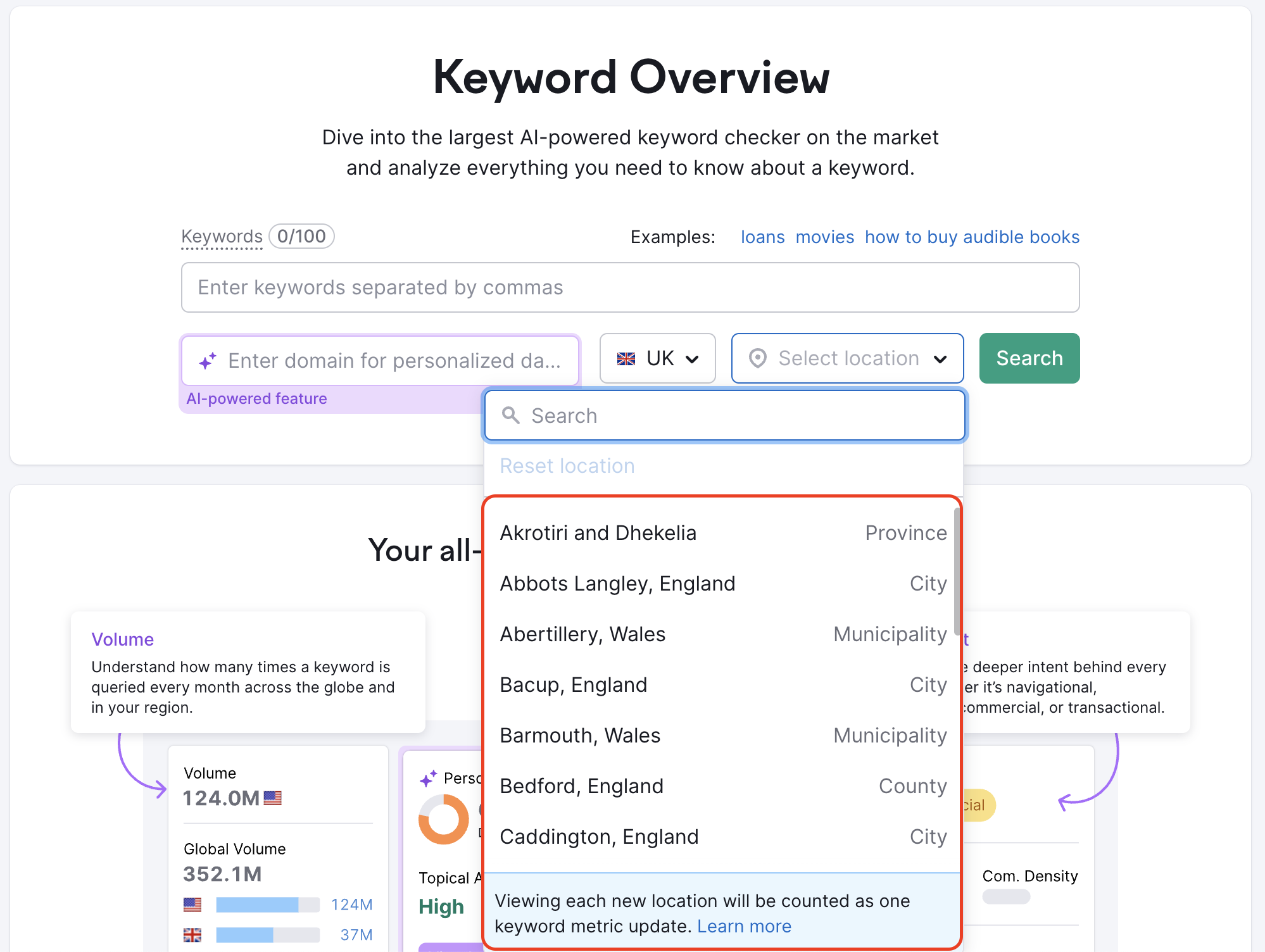
Dit is alleen beschikbaar voor zoekopdrachten met één zoekwoord, niet voor bulk.
Lokale gegevens kunnen ook worden opgevraagd in de Keyword Overview-tool. Hier kun je gemakkelijk onderscheiden welke statistieken lokale gegevens en welke nationale gegevens weergeven.

Elke nieuwe locatie die je bekijkt, wordt meegeteld als 1 in je limiet voor "zoekwoordupdates".
Wanneer je de filter voor lokale statistieken gebruikt, krijg je lokale gegevens voor een zoekwoord:
- Volume
- Volumetrend
- Zoekwoordmoeilijkheid (KD %)
- Concurrentiedichtheid
- Kosten per klik (CPC)
- Intentie
- SERP-analyse
- SERP-functies
- Resultaten
Zoekwoorden in bulk analyseren
In het tabblad Bulk Analysis kun je de statistieken analyseren voor tot wel 100 zoekwoorden. Je krijgt voor elk zoekwoord het volume, de trend, de zoekwoordmoeilijkheid, de CPC, de concurrentiedichtheid, de SERP-functies en de resultaten.
Na het vergelijken van de zoekwoorden, kun je diegene die het best aansluiten bij jouw SEO-strategie naar de Keyword Strategy Builder sturen. Dat is een opslagplaats voor alle zoekwoorden die je hebt verzameld in verschillende Semrush-tools.
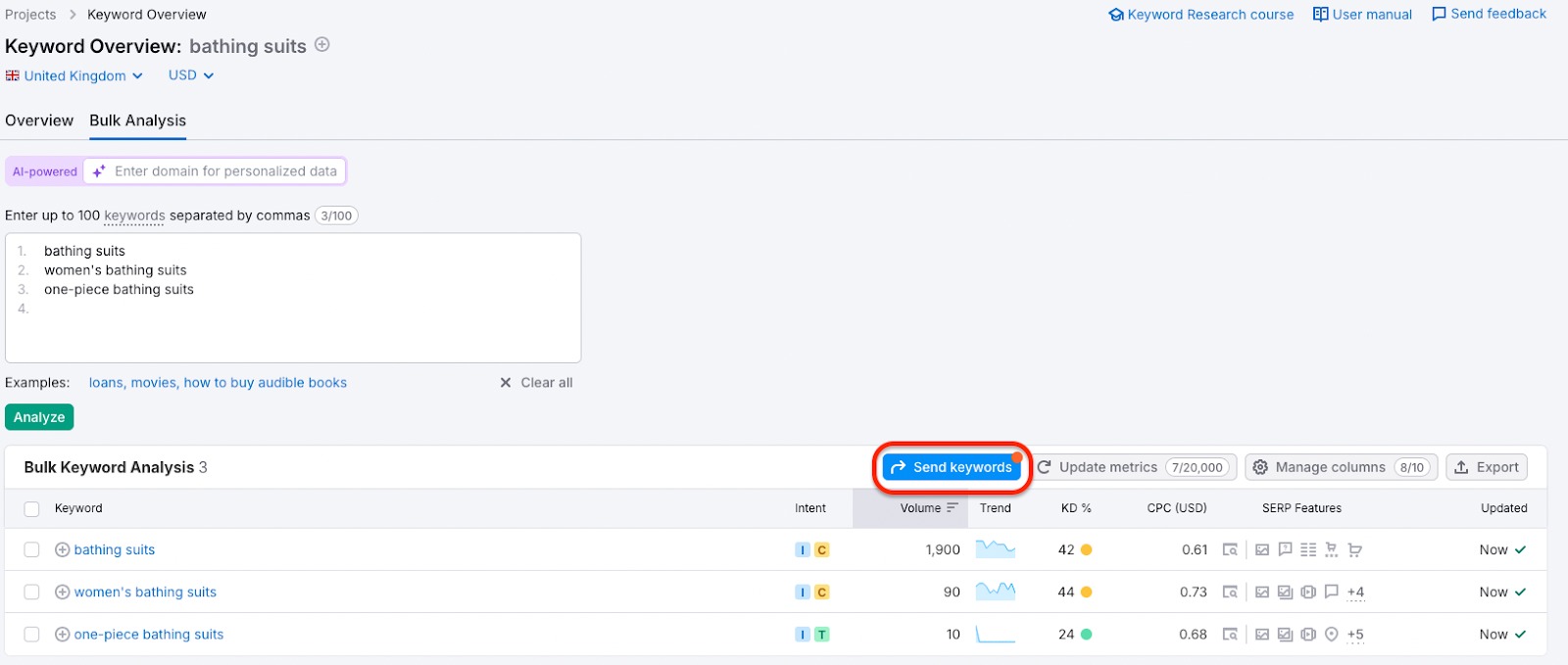
Let op: lokale zoekwoordstatistieken zijn niet beschikbaar in het Bulk Analysis-rapport.
Het Bulk Analysis-rapport heeft ook een optie om kolommen te beheren. Door op de knop "Kolommen beheren" te klikken, kun je de gegevens selecteren die je in je rapport wilt zien.

Momenteel laat de Keyword Overview-tool je alleen de historische gegevens bekijken voor één specifiek zoekwoord tegelijkertijd. Met Bulk Analysis kun je reeksen zoekwoorden analyseren, maar de statistieken zijn altijd actueel.
Tip: je kunt historische gegevens krijgen voor zoekwoorden in bulk door de Semrush-API Batch Keyword Overview op te roepen. Het standaard API-pakket is inbegrepen bij een Business SEO Toolkit-abonnement.
Exportopties
Exporteer gegevens van Keyword Overview (Overview-rapport) naar pdf of maak je eigen aangepaste rapport met de tool Mijn rapporten. Combineer gegevens uit Traffic Analytics, andere Semrush-tools, Google Analytics 4, Google Search Console, en andere bronnen om aangepaste pdf-rapporten te maken. Stem de rapporten af op je merk en plan automatische updates voor naadloze rapportautomatisering.
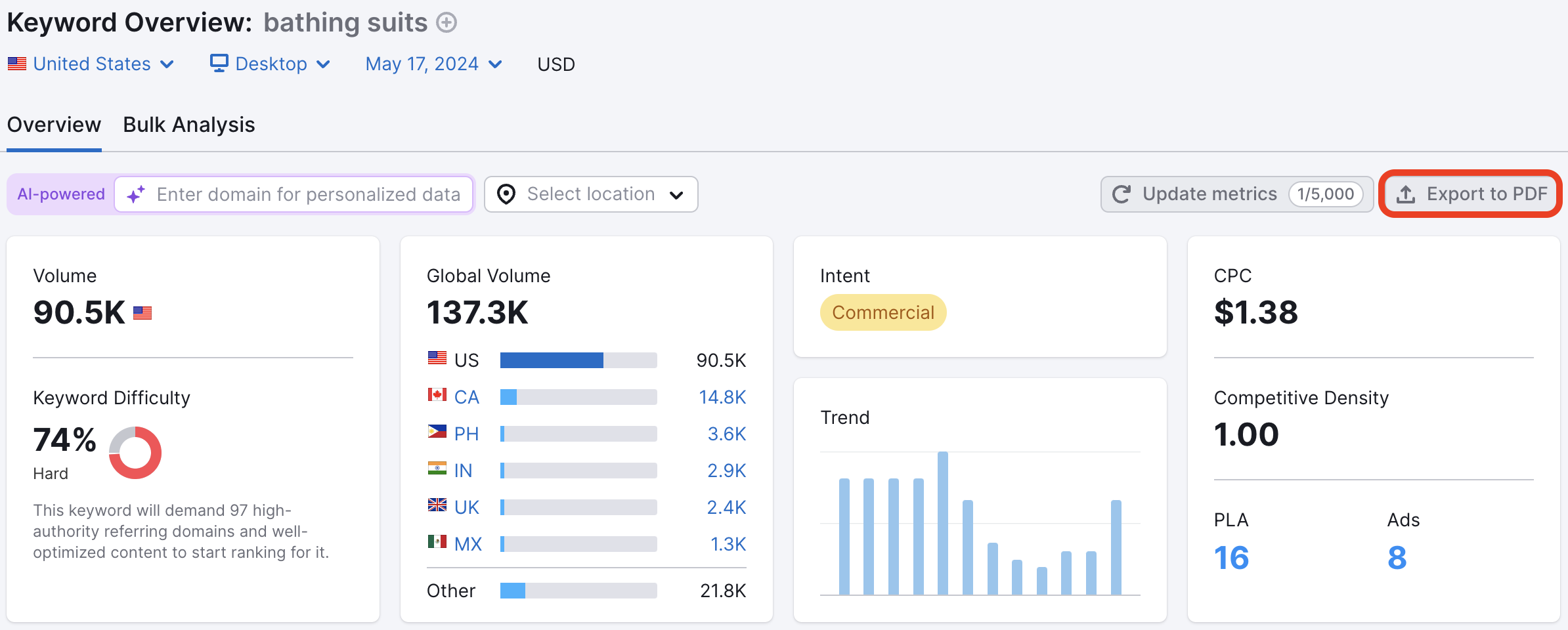
Je kunt je zoekwoordenlijst uit Keyword Overview exporteren als CSV, XLSX of CSV Semicolon (puntkomma).

Je kunt de gegevens ook exporteren door ze naar het klembord te kopiëren en in je bestand te plakken. Als je een of meer zoekwoorden selecteert, verschijnt de knop "Kopiëren" in de header van de tabel. Klik op "Kopiëren" en plak de geselecteerde zoekwoorden in een bestand naar keuze.

Je kunt zoekwoorden een voor een selecteren door op elk individueel selectievakje te klikken of je kunt ze allemaal tegelijk selecteren. Om een opeenvolgende groep zoekwoorden in de lijst te selecteren, klik je op het eerste zoekwoord in de groep. Houd vervolgens de Shift-toets ingedrukt terwijl je het laatste zoekwoord in de groep aanklikt. Op die manier kun je alles tussen de twee zoekwoorden selecteren.

Limieten
De Keyword Overview-tool maakt deel uit van de SEO Toolkit. De gebruikslimieten zijn afhankelijk van je abonnementversie. Historische zoekwoordgegevens kun je alleen bekijken met een Guru- of Business-versie van de SEO Toolkit.
Limieten voor dagelijkse verzoeken:
- Pro SEO: tot 3.000 verzoeken per dag
- Guru SEO: tot 5.000 verzoeken per dag
- Business SEO: tot 10.000 verzoeken per dag
Maandelijkse zoekwoordupdates
- Pro SEO: 250 updates per maand
- Guru SEO: 1.000 updates per maand
- Business SEO: 5.000 updates per maand